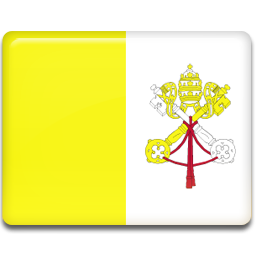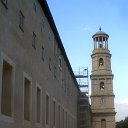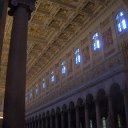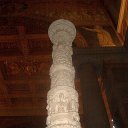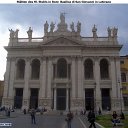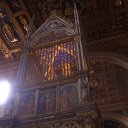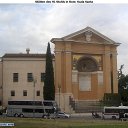UNESCO Welterbe Europa: Galerie & Aufnahmekriterien
HISTORISCHES ZENTRUM ROMS, DIE EXTRATERRITORIALEN STÄTTEN DES HEILIGEN STUHLS IN DER STADT UND SANKT PAUL VOR DEN MAUERN Centro storico di Roma, le proprietà extraterritoriali della Santa Sede nella città e San Paolo fuori le Mura (K/GÜ/1980; 1990 erweitert) Historic Centre of Rome, the Properties of the Holy See in that City Enjoying Extraterritorial Rights and San Paolo Fuori le Mura Centre historique de Rome, les biens du Saint-Siège situés dans cette ville bénéficiant des droits d'extra-territorialité et Saint-Paul-hors-les-Murs |
Zum Vergrößern ins Bild klicken
Erfüllte Kriterien für die Aufnahme in die UNESCO-Welterbeliste:
(i) (ii) (iii) (iv) (vi)
Entscheidung CONF 016 V.12, Ref/ID 91ter (4. Sitzung, Paris/Frankreich, 1980) Erweiterung: 14COM VII.B, Ref/ID 91bis (14. Sitzung, Banff/Kanada, 1990)
|
|||
Kriterien für die Aufnahme:
Das Komitee betrachtet ein Gut als von außergewöhnlichem universellem Wert, wenn das Gut einem oder mehreren der folgenden Kriterien entspricht. Angemeldete Güter sollten daher
|
Begründung für die Aufnahme: |
||
(i) ein Meisterwerk der menschlichen Schöpferkraft darstellen
|
(i) The property includes a series of testimonies of incomparable artistic value produced over almost three millennia of history: monuments of antiquity (like the Colosseum, the Pantheon, the complex of the Roman and the Imperial Forums), fortifications built over the centuries (like the city walls and Castel Sant’Angelo), urban developments from the Renaissance and Baroque periods up to modern times (like Piazza Navona and the “Trident” marked out by Sixtus V (1585-1590) including Piazza del Popolo and Piazza di Spagna), civil and religious buildings, with sumptuous pictorial, mosaic and sculptural decorations (like the Capitoline Hill and the Farnese and Quirinale Palaces, the Ara Pacis, the Major Basilicas of Saint John Lateran, Saint Mary Major and Saint Paul’s Outside the Walls), all created by some of the most renowned artists of all time.
[Übersetzung in meinem kommenden Buch]
|
||
(ii) für einen Zeit- oder in einem Kulturgebiet der Erde einen bedeutenden Schnittpunkt menschlicher Werte in Bezug auf Entwicklung der Architektur oder Technik, der Großplastik, des Städtebaus oder der Landschaftsgestaltung aufzeigen
|
(ii) Over the centuries, the works of art found in Rome have had a decisive influence on the development of urban planning, architecture, technology and the arts throughout the world. The achievements of ancient Rome in the fields of architecture, painting and sculpture served as a universal model not only in antiquity, but also in the Renaissance, Baroque and Neoclassical periods. The classical buildings and the churches, palaces and squares of Rome have been an unquestioned point of reference, together with the paintings and sculptures that enrich them. In a particular way, it was in Rome that Baroque art was born and then spread throughout Europe and to other continents.
[Übersetzung in meinem kommenden Buch]
|
||
(iii) ein einzigartiges oder zumindest außergewöhnliches Zeugnis von einer kulturellen Tradition oder einer bestehenden oder untergegangenen Kultur darstellen
|
(iii) The value of the archaeological sites of Rome, the centre of the civilization named after the city itself, is universally recognized. Rome has maintained an extraordinary number of monumental remains of antiquity which have always been visible and are still in excellent state of preservation. They bear unique witness to the various periods of development and styles of art, architecture and urban design, characterizing more than a millennium of history. would be difficult to find a city, which offers in as limited an area as many unique aesthetic creations, whose influence on the evolution of art and architecture has been as great.
[Übersetzung in meinem kommenden Buch]
|
||
(iv) ein hervorragendes Beispiel eines Typus von Gebäuden, architektonischen oder technologischen Ensembles oder Landschaften darstellen, die einen oder mehrere bedeutsame Abschnitte der Menschheits-Geschichte versinnbildlichen
|
(iv) The historic centre of Rome as a whole, as well as its buildings, testifies to the uninterrupted sequence of three millennia of history. The specific characteristics of the site are the stratification of architectural languages, the wide range of building typologies and original developments in urban planning which are harmoniously integrated in the city’s complex morphology.
Worthy of mention are significant civil monuments such as the Forums, Baths, city walls and palaces; religious buildings, from the remarkable examples of the early Christian basilicas of Saint Mary Major, St John Lateran and St Paul’s Outside the Walls to the Baroque churches; the water systems (drainage, aqueducts, the Renaissance and Baroque fountains, and the 19th-century flood walls along the Tiber). This evidently complex diversity of styles merges to make a unique ensemble, which continues to evolve in time.
[Übersetzung in meinem kommenden Buch]
|
||
(v) ein hervorragendes Beispiel einer überlieferten menschlichen Siedlungsform, Boden- oder Meeresnutzung darstellen,die für eine oder mehrere bestimmte Kulturen typisch ist, oder der Wechselwirkung zwischen Mensch und Umwelt, insbesondere, wenn diese unter dem Druck unaufhaltsamen Wandels vom Untergang bedroht wird
|
|||
(vi) in unmittelbarer oder erkennbarer Weise mit Ereignissen oder überlieferten Lebensformen, mit Ideen oder Glaubensbekenntnissen oder mit künstlerischen oder literarischen Werken von außergewöhnlicher universeller Bedeutung verknüpft sein. (Das Komitee ist der Ansicht, dass dieses Kriterium in der Regel nur in Verbindung mit einem weiteren Kriterium angewandt werden sollte)
|
(vi) For more than two thousand years, Rome has been both a secular and religious capital. As the centre of the Roman Empire which extended its power throughout the then known world, the city was the heart of a widespread civilization that found its highest expression in law, language and literature, and remains the basis of Western culture. Rome has also been directly associated with the history of the Christian faith since its origins. The Eternal City was for centuries, and remains today, a symbol and one of the most venerable goals of pilgrimages, thanks to the Tombs of Apostles, the Saints and Martyrs, and to the presence of the Pope.
[Übersetzung in meinem kommenden Buch]
|
||
(vii) überragende Naturerscheinungen oder Gebiete von außergewöhnlicher Naturschönheit und ästhetischer Bedeutung aufweisen
|
|||
(viii) außergewöhnliche Beispiele der Hauptstufen der Erdgeschichte darstellen, einschließlich der Entwicklung des Lebens, wesentlicher im Gang befindlicher geologischer Prozesse bei der Entwicklung von Landschaftsformen oder wesentlicher geomorphologischer oder physiographischer Merkmale
|
|||
(ix) außergewöhnliche Beispiele bedeutender im Gang befindlicher ökologischer und biologischer Prozesse in der Evolution und Entwicklung von Land-, Süßwasser-, Küsten- und Meeres-Ökosystemen sowie Pflanzen- und Tiergemeinschaften darstellen
|
|||
(x) die für die In-situ-Erhaltung der biologischen Vielfalt bedeutendsten und typischsten Lebensräume enthalten, einschließlich solcher, die bedrohte Arten enthalten, welche aus wissenschaftlichen Gründen oder ihrer Erhaltung wegen von außergewöhnlichem universellem Wert sind.
|
|||
Quelle: Deutsche UNESCO-Kommission e.V. |
Quelle: UNESCO World Heritage Centre |
||
